Convert an Excel document to PDF in Blazor
6 Nov 202524 minutes to read
Syncfusion® XlsIO is a Blazor Excel library used to create, read, edit and convert Excel documents programmatically without Microsoft Excel or interop dependencies. Using this library, you can convert an Excel document to PDF in Blazor.
Excel to PDF in Blazor Server App
Step 1: Create a new C# Blazor Server app project.
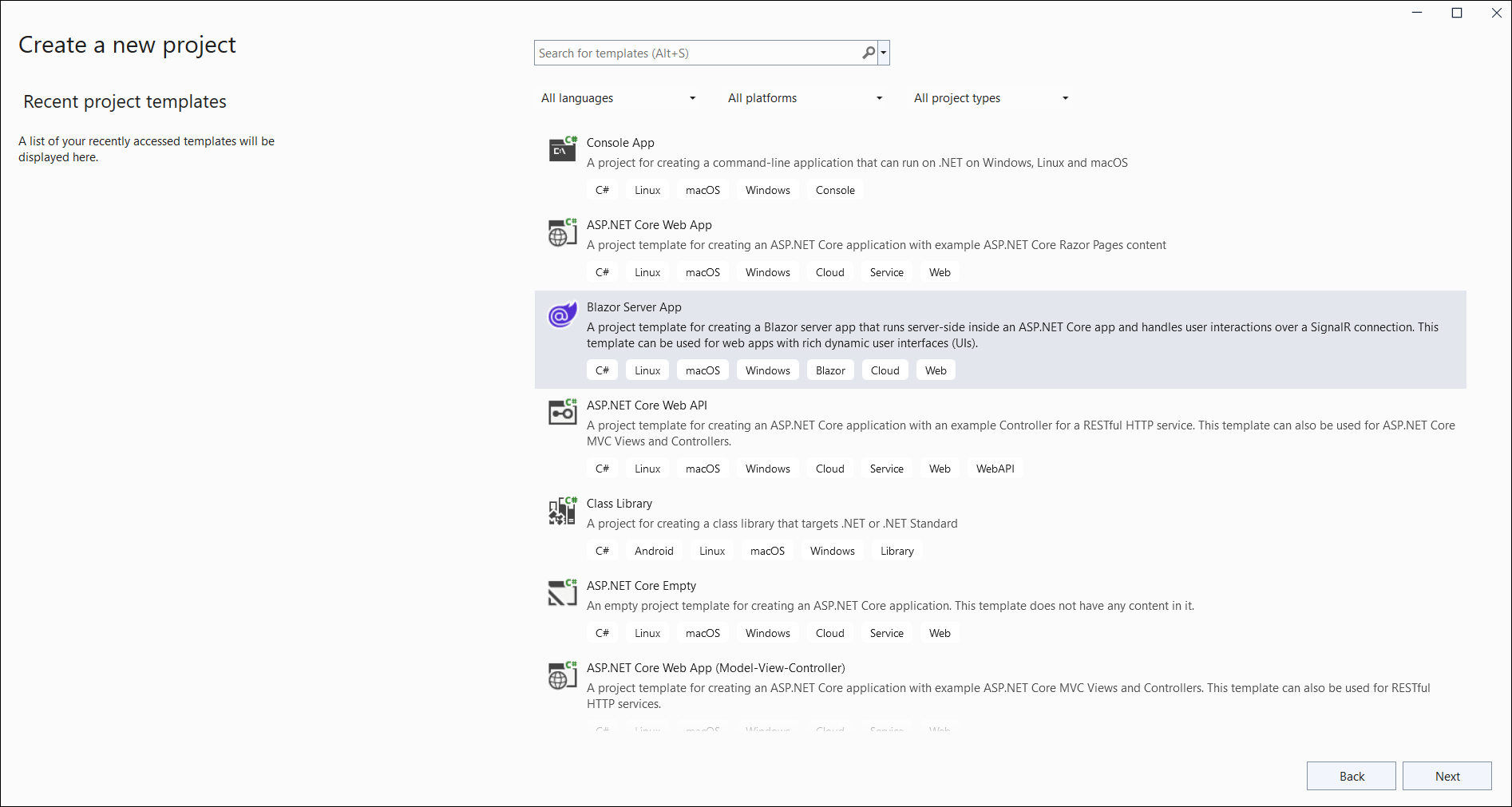
Step 2: Name the project.
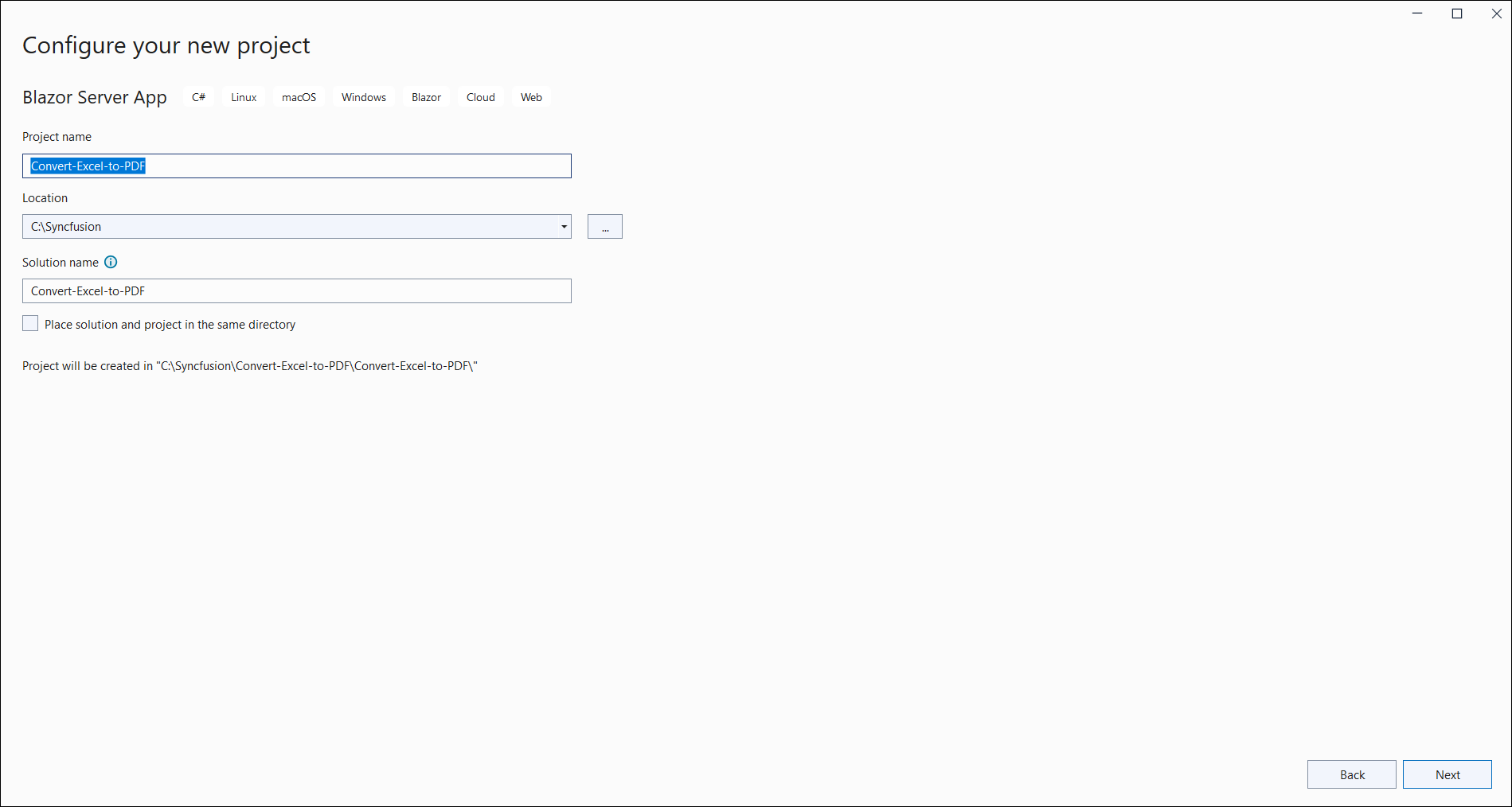
Step 3: Select the framework and click Create button.

Step 4: Install the Syncfusion.XlsIORenderer.Net.Core NuGet package as a reference to your project from NuGet.org.
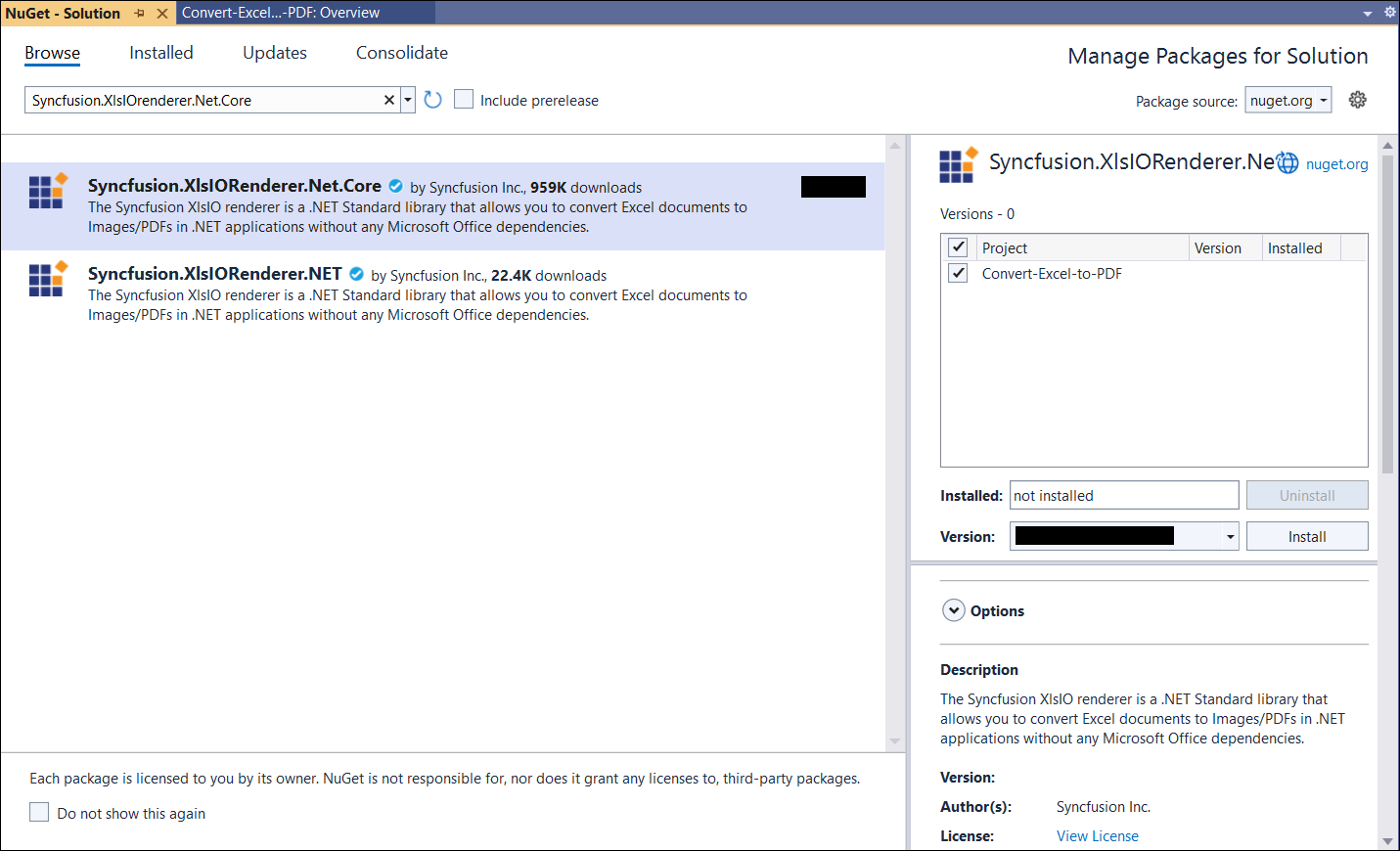
NOTE
Starting with v16.2.0.x, if you reference Syncfusion® assemblies from trial setup or from the NuGet feed, you also have to add “Syncfusion.Licensing” assembly reference and include a license key in your projects. Please refer to this link to know about registering Syncfusion® license key in your applications to use our components
Step 5: Create a razor file with name as XlsIO under Pages folder and include the following namespaces in the file.
@page "/xlsio"
@using Convert_Excel_to_PDF;
@inject Convert_Excel_to_PDF.Data.ExcelService service
@inject Microsoft.JSInterop.IJSRuntime JSStep 6: Add the following code in XlsIO.razor file to create a new button.
<h2>Syncfusion XlsIO library </h2>
<p>Syncfusion Blazor XlsIO library is used to create, read, edit, and convert Excel files in your applications without Microsoft Office dependencies.</p>
<button class="btn btn-primary" @onclick="@ConvertExceltoPDF">Convert Excel to PDF</button>Step 7: Add the following code in XlsIO.razor file to create and download the PDF document.
@code {
MemoryStream documentStream;
/// <summary>
/// Convert Excel to PDF and download the PDF document
/// </summary>
protected async void ConvertExceltoPDF()
{
documentStream = service.ConvertExceltoPDF();
await JS.SaveAs("Sample.pdf", documentStream.ToArray());
}
}Step 8: Create a new cs file with name as ExcelService under Data folder and include the following namespaces in the file.
using Syncfusion.XlsIO;
using Syncfusion.Pdf;
using Syncfusion.XlsIORenderer;Step 9: Create a new MemoryStream method with name as ConvertExceltoPDF in ExcelService class and include the following code snippet to convert an Excel document to Pdf in Server app.
using (ExcelEngine excelEngine = new ExcelEngine())
{
IApplication application = excelEngine.Excel;
application.DefaultVersion = ExcelVersion.Xlsx;
// Open the workbook.
IWorkbook workbook = application.Workbooks.Open(@"wwwroot/InputTemplate.xlsx");
// Instantiate the Excel to PDF renderer.
XlsIORenderer renderer = new XlsIORenderer();
//Convert Excel document into PDF document
PdfDocument pdfDocument = renderer.ConvertToPDF(workbook);
//Create the MemoryStream to save the converted PDF.
MemoryStream pdfStream = new MemoryStream();
//Save the converted PDF document to MemoryStream.
pdfDocument.Save(pdfStream);
pdfStream.Position = 0;
return pdfStream;
}Step 10: Create a new class file in the project, with name as FileUtils and add the following code to invoke the JavaScript action to download the file in the browser.
public static class FileUtils
{
public static ValueTask<object> SaveAs(this IJSRuntime js, string filename, byte[] data)
=> js.InvokeAsync<object>(
"saveAsFile",
filename,
Convert.ToBase64String(data));
}Step 11: Add the following JavaScript function in the _Host.cshtml in the Pages folder.
<script type="text/javascript">
function saveAsFile(filename, bytesBase64) {
if (navigator.msSaveBlob) {
//Download document in Edge browser
var data = window.atob(bytesBase64);
var bytes = new Uint8Array(data.length);
for (var i = 0; i < data.length; i++) {
bytes[i] = data.charCodeAt(i);
}
var blob = new Blob([bytes.buffer], { type: "application/octet-stream" });
navigator.msSaveBlob(blob, filename);
}
else {
var link = document.createElement('a');
link.download = filename;
link.href = "data:application/octet-stream;base64," + bytesBase64;
document.body.appendChild(link); // Needed for Firefox
link.click();
document.body.removeChild(link);
}
}
</script>Step 12: Add the following code snippet in the NavMenu.razor in the Shared folder.
<li class="nav-item px-3">
<NavLink class="nav-link" href="xlsio">
<span class="oi oi-list-rich" aria-hidden="true"></span> Convert Excel to PDF
</NavLink>
</li>Step 1: Create a new C# Blazor Server app project using Create .NET Project option.

Step 2: Name the project and create the project.

Alternatively, create a Blazor Server application using the following command in the terminal(Ctrl+`).
dotnet new blazorserver -o Convert-Excel-to-PDF
cd Convert-Excel-to-PDF
Step 3: To convert an Excel document to PDF in Blazor,run the following command to install Syncfusion.XlsIORenderer.Net.Core package.

dotnet add package Syncfusion.XlsIORenderer.Net.Core
NOTE
Starting with v16.2.0.x, if you reference Syncfusion® assemblies from trial setup or from the NuGet feed, you also have to add “Syncfusion.Licensing” assembly reference and include a license key in your projects. Please refer to this link to know about registering Syncfusion® license key in your applications to use our components
Step 4: Create a razor file with name as XlsIO under Pages folder and include the following namespaces in the file.
@page "/xlsio"
@using Convert_Excel_to_PDF;
@inject Convert_Excel_to_PDF.Data.ExcelService service
@inject Microsoft.JSInterop.IJSRuntime JSStep 5: Add the following code in XlsIO.razor file to create a new button.
<h2>Syncfusion XlsIO library </h2>
<p>Syncfusion Blazor XlsIO library is used to create, read, edit, and convert Excel files in your applications without Microsoft Office dependencies.</p>
<button class="btn btn-primary" @onclick="@ConvertExceltoPDF">Convert Excel to PDF</button>Step 6: Add the following code in XlsIO.razor file to create and download the PDF document.
@code {
MemoryStream documentStream;
/// <summary>
/// Convert Excel to PDF and download the PDF document
/// </summary>
protected async void ConvertExceltoPDF()
{
documentStream = service.ConvertExceltoPDF();
await JS.SaveAs("Sample.pdf", documentStream.ToArray());
}
}Step 7: Create a new cs file with name as ExcelService under Data folder and include the following namespaces in the file.
using Syncfusion.XlsIO;
using Syncfusion.Pdf;
using Syncfusion.XlsIORenderer;Step 8: Create a new MemoryStream method with name as ConvertExceltoPDF in ExcelService class and include the following code snippet to convert an Excel document to Pdf in Server app.
using (ExcelEngine excelEngine = new ExcelEngine())
{
IApplication application = excelEngine.Excel;
application.DefaultVersion = ExcelVersion.Xlsx;
// Open the workbook.
IWorkbook workbook = application.Workbooks.Open(@"wwwroot/InputTemplate.xlsx");
// Instantiate the Excel to PDF renderer.
XlsIORenderer renderer = new XlsIORenderer();
//Convert Excel document into PDF document
PdfDocument pdfDocument = renderer.ConvertToPDF(workbook);
//Create the MemoryStream to save the converted PDF.
MemoryStream pdfStream = new MemoryStream();
//Save the converted PDF document to MemoryStream.
pdfDocument.Save(pdfStream);
pdfStream.Position = 0;
return pdfStream;
}Step 9: Create a new class file in the project, with name as FileUtils and add the following code to invoke the JavaScript action to download the file in the browser.
public static class FileUtils
{
public static ValueTask<object> SaveAs(this IJSRuntime js, string filename, byte[] data)
=> js.InvokeAsync<object>(
"saveAsFile",
filename,
Convert.ToBase64String(data));
}Step 10: Add the following JavaScript function in the _Host.cshtml in the Pages folder.
<script type="text/javascript">
function saveAsFile(filename, bytesBase64) {
if (navigator.msSaveBlob) {
//Download document in Edge browser
var data = window.atob(bytesBase64);
var bytes = new Uint8Array(data.length);
for (var i = 0; i < data.length; i++) {
bytes[i] = data.charCodeAt(i);
}
var blob = new Blob([bytes.buffer], { type: "application/octet-stream" });
navigator.msSaveBlob(blob, filename);
}
else {
var link = document.createElement('a');
link.download = filename;
link.href = "data:application/octet-stream;base64," + bytesBase64;
document.body.appendChild(link); // Needed for Firefox
link.click();
document.body.removeChild(link);
}
}
</script>Step 11: Add the following code snippet in the NavMenu.razor in the Shared folder.
<li class="nav-item px-3">
<NavLink class="nav-link" href="xlsio">
<span class="oi oi-list-rich" aria-hidden="true"></span> Convert Excel to PDF
</NavLink>
</li>A complete working example of how to convert an Excel document to PDF in Blazor Server App is present on this GitHub page.
By executing the program, you will get the PDF document as follows.
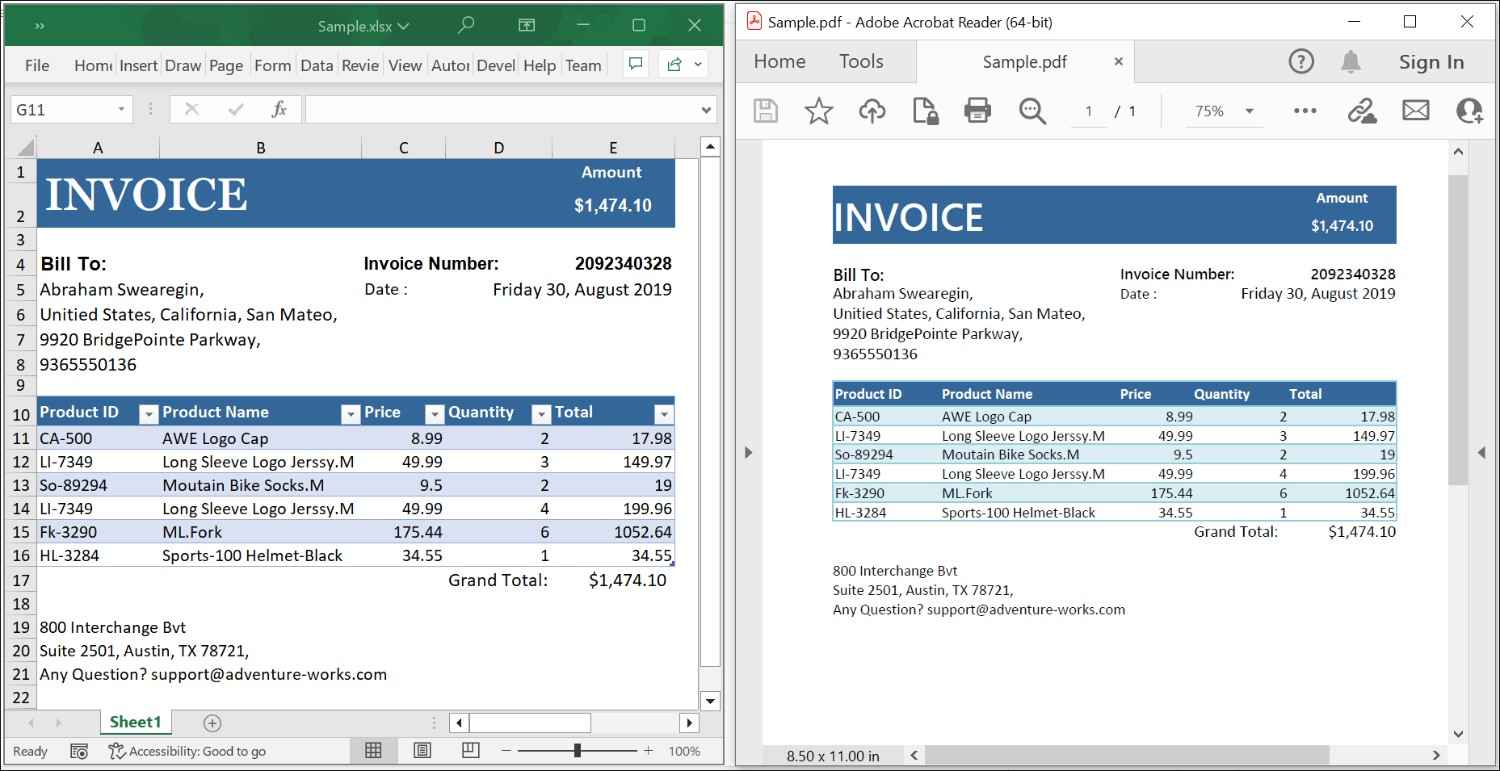
Click here to explore the rich set of Syncfusion® Excel library (XlsIO) features.
An online sample link to convert an Excel document to PDF in Blazor.
Excel to PDF in Blazor WASM app
Step 1: Create a new C# Blazor WASM app project.
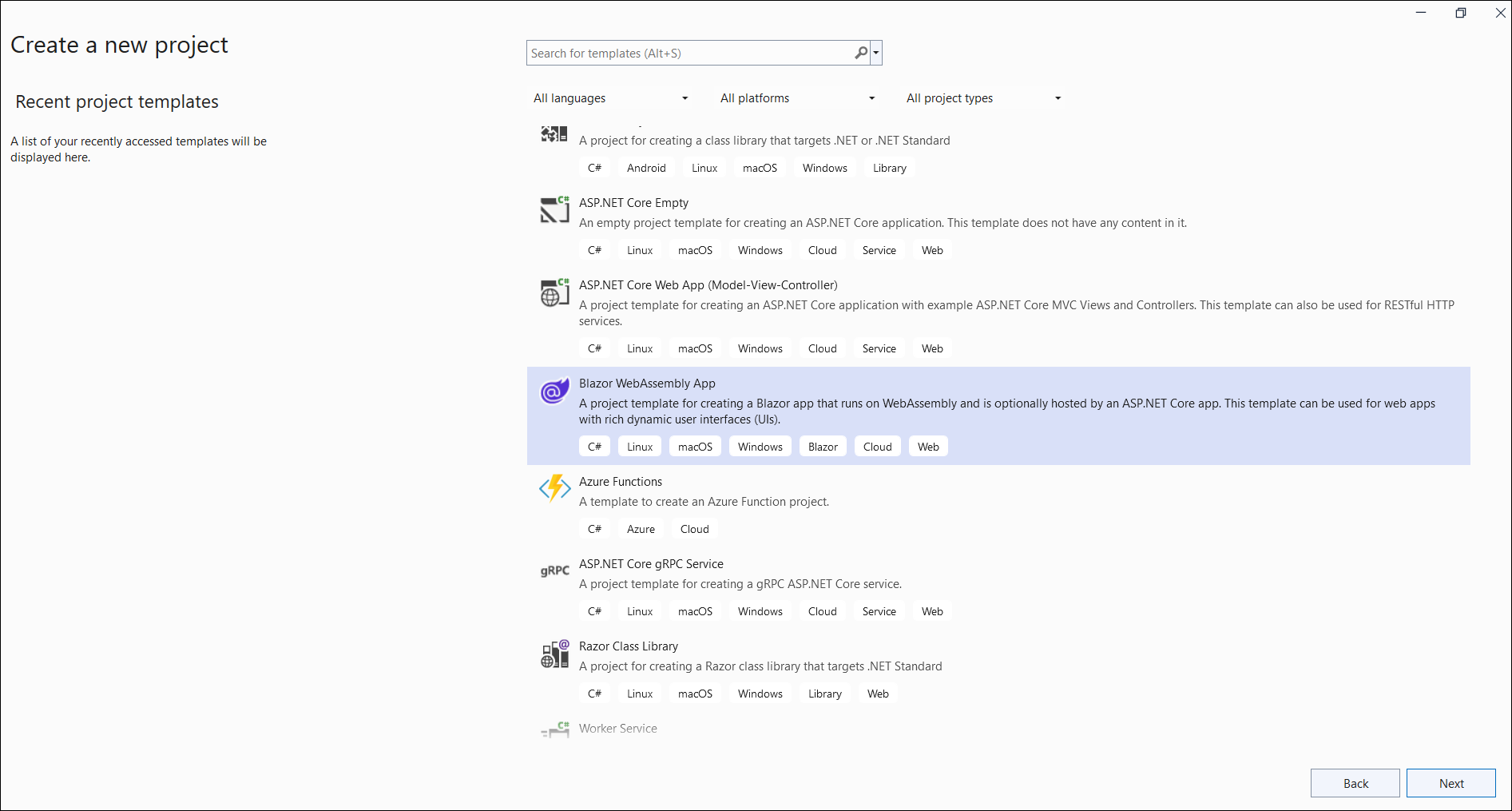
Step 2: Name the project.
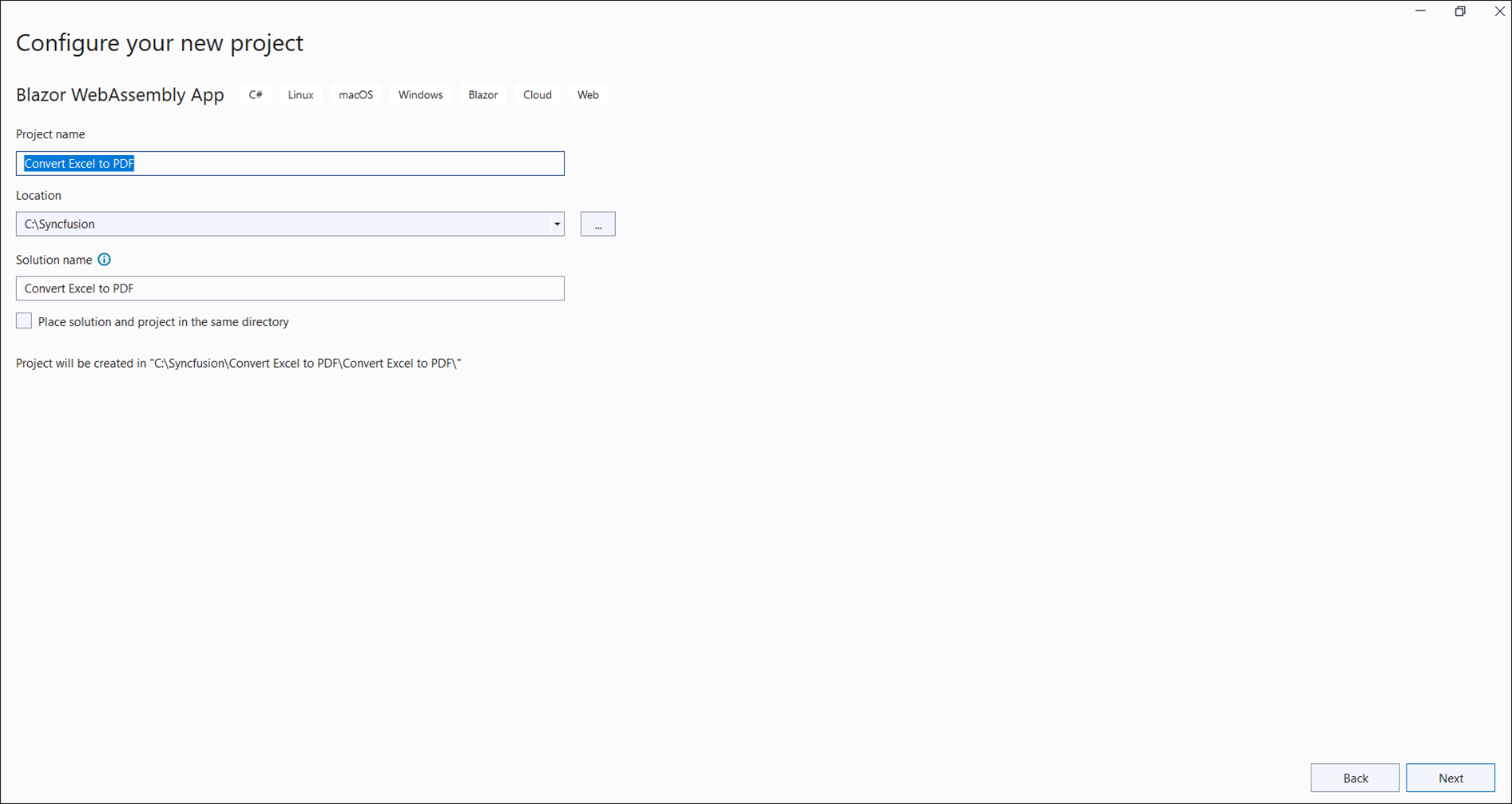
Step 3: Select the framework and click Create button.
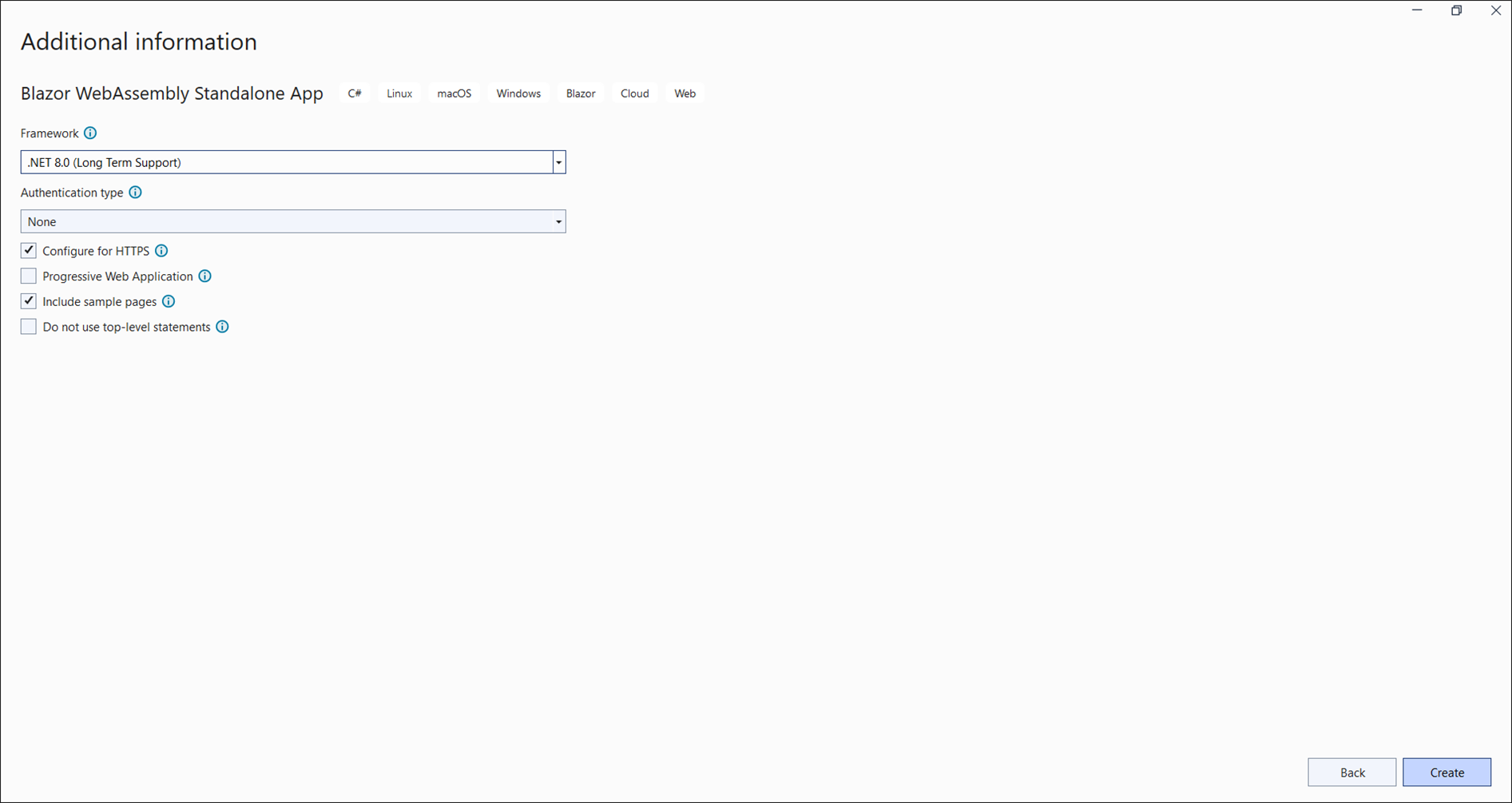
Step 4: Install the following Nuget packages in your application from NuGet.org.
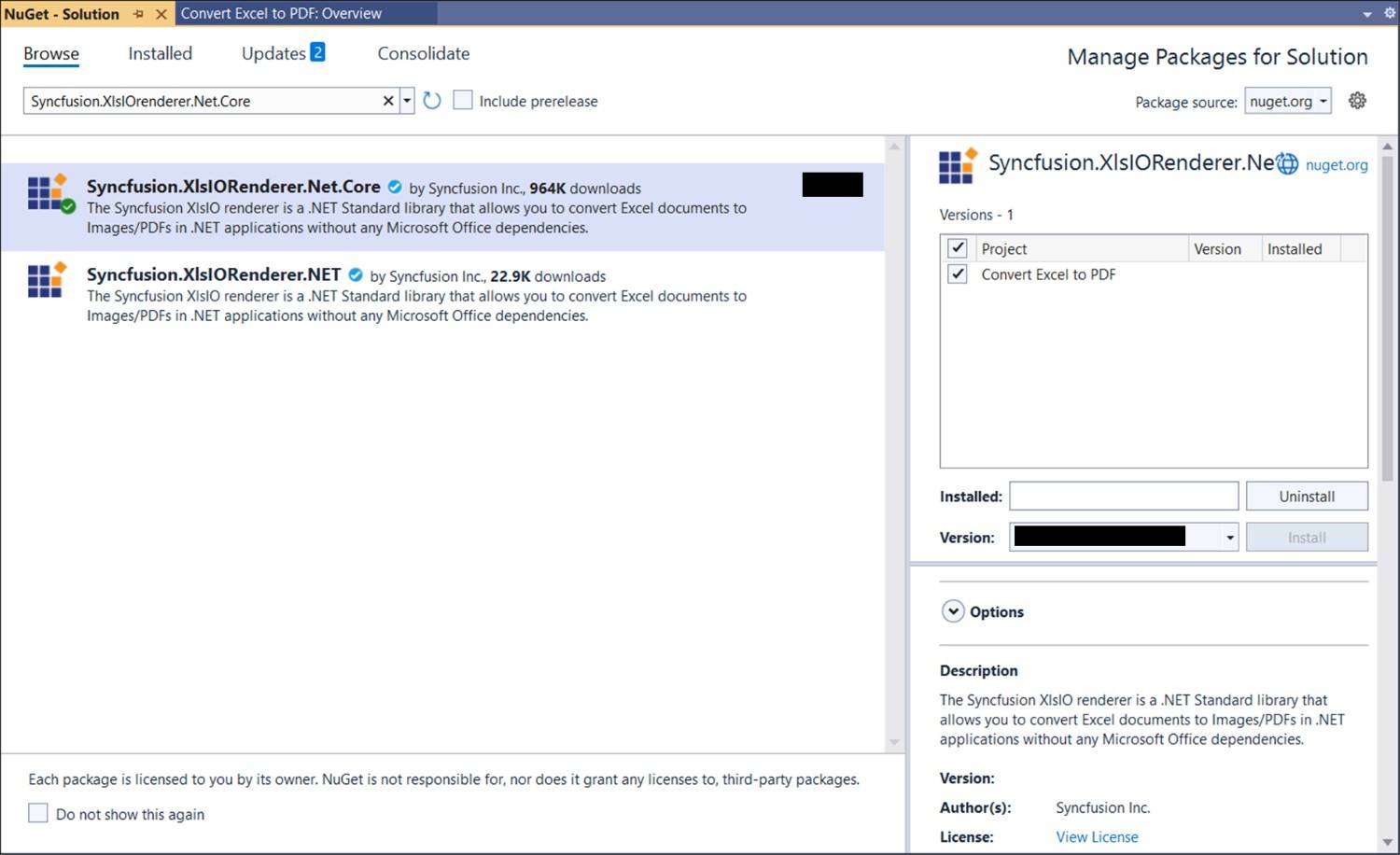
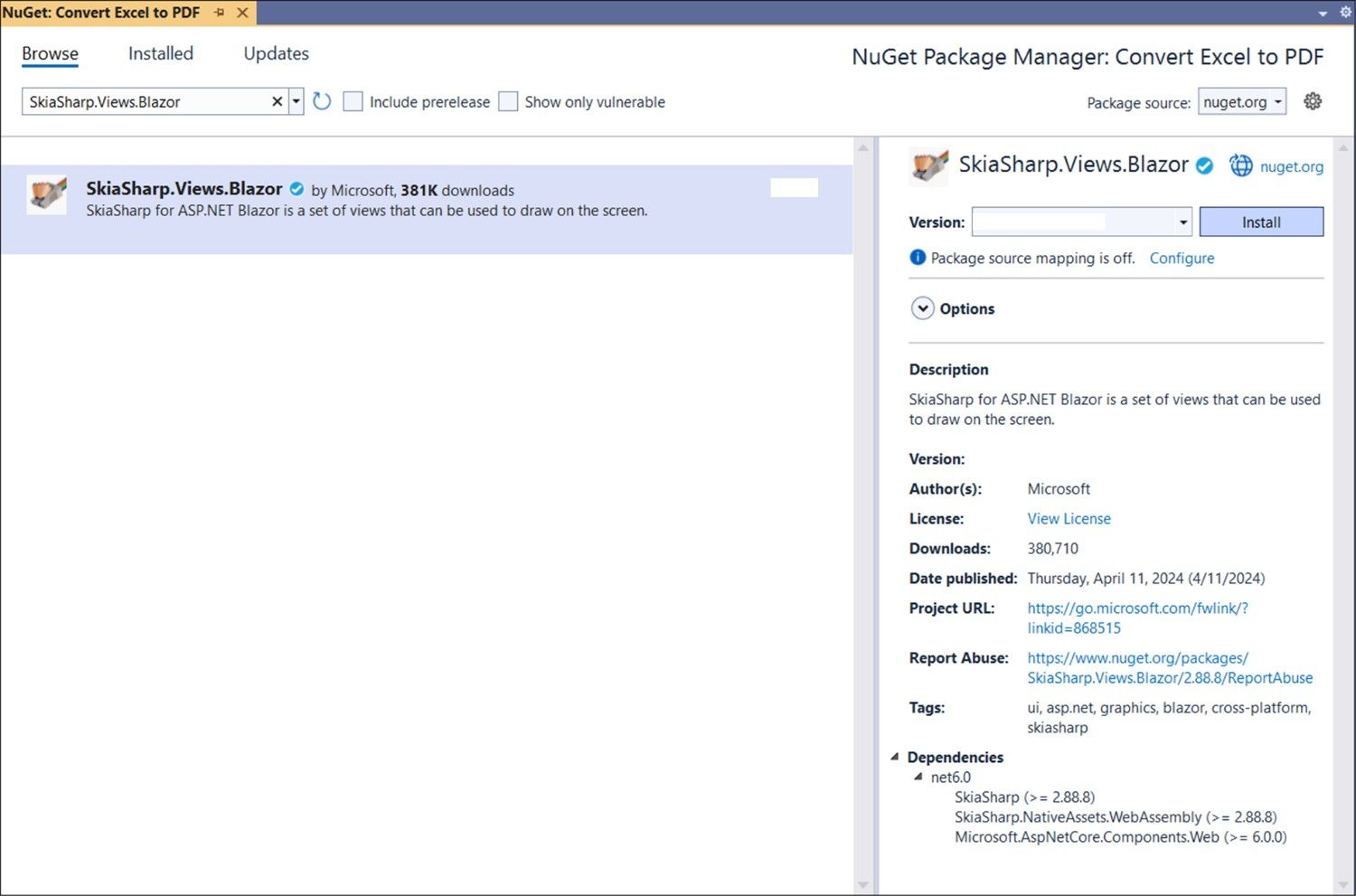
NOTE
Starting with v16.2.0.x, if you reference Syncfusion® assemblies from trial setup or from the NuGet feed, you also have to add “Syncfusion.Licensing” assembly reference and include a license key in your projects. Please refer to this link to know about registering Syncfusion® license key in your application to use our components.
Step 5: Add the following ItemGroup tag in the Blazor WASM csproj file.
<ItemGroup>
<NativeFileReference Include="$(SkiaSharpStaticLibraryPath)\2.0.23\*.a" />
</ItemGroup>NOTE
Install this wasm-tools and wasm-tools-net6 by using the “dotnet workload install wasm-tools” and “dotnet workload install wasm-tools-net6” commands in your command prompt respectively if you are facing issues related to Skiasharp during runtime.
Step 6: Enable the following property in the Blazor WASM csproj file.
<PropertyGroup>
<WasmNativeStrip>true</WasmNativeStrip>
</PropertyGroup>Step 7: Create a razor file with name as XlsIO under Pages folder and include the following namespaces in the file.
@page "/xlsio"
@using Syncfusion.XlsIO
@using Syncfusion.Pdf
@using Syncfusion.XlsIORenderer
@inject Microsoft.JSInterop.IJSRuntime JS
@inject HttpClient clientStep 8: Add the following code to create a new button.
<h2>Syncfusion XlsIO library</h2>
<p>Syncfusion Blazor XlsIO library used to create, read, edit, and convert DocIO files in your applications without Microsoft Office dependencies.</p>
<button class="btn btn-primary" @onclick="@ExcelToPDF">Convert Excel to PDF</button>Step 9: Create a new async method with name as ExcelToPDF and include the following code snippet to create an Excel document in Blazor WASM app.
using (ExcelEngine excelEngine = new ExcelEngine())
{
IApplication application = excelEngine.Excel;
application.DefaultVersion = ExcelVersion.Xlsx;
//Load an existing file
using (Stream inputStream = await client.GetStreamAsync("Data/InputTemplate.xlsx"))
{
// Open the workbook.
IWorkbook workbook = application.Workbooks.Open(inputStream);
// Instantiate the Excel to PDF renderer.
XlsIORenderer renderer = new XlsIORenderer();
//Convert Excel document into PDF document
PdfDocument pdfDocument = renderer.ConvertToPDF(workbook);
//Create the MemoryStream to save the converted PDF.
MemoryStream pdfStream = new MemoryStream();
//Save the converted PDF document to MemoryStream.
pdfDocument.Save(pdfStream);
pdfStream.Position = 0;
//Download PDF file in the browser.
await JS.SaveAs("Output.pdf", pdfStream.ToArray());
}
}Step 10: Create a class file with FileUtils name and add the following code to invoke the JavaScript action to download the file in the browser.
public static class FileUtils
{
public static ValueTask<object> SaveAs(this IJSRuntime js, string filename, byte[] data)
=> js.InvokeAsync<object>(
"saveAsFile",
filename,
Convert.ToBase64String(data));
}Step 11: Add the following JavaScript function in the Index.html file present under wwwroot.
<script type="text/javascript">
function saveAsFile(filename, bytesBase64) {
if (navigator.msSaveBlob) {
//Download document in Edge browser
var data = window.atob(bytesBase64);
var bytes = new Uint8Array(data.length);
for (var i = 0; i < data.length; i++) {
bytes[i] = data.charCodeAt(i);
}
var blob = new Blob([bytes.buffer], { type: "application/octet-stream" });
navigator.msSaveBlob(blob, filename);
}
else {
var link = document.createElement('a');
link.download = filename;
link.href = "data:application/octet-stream;base64," + bytesBase64;
document.body.appendChild(link); // Needed for Firefox
link.click();
document.body.removeChild(link);
}
}
</script>Step 12: Add the following code snippet in the NavMenu.razor in the Shared folder
<li class="nav-item px-3">
<NavLink class="nav-link" href="xlsio">
<span class="oi oi-list-rich" aria-hidden="true"></span> Convert Excel to PDF
</NavLink>
</li>Step 1: Create a new C# Blazor WASM app project.

Step 2: Name the project and create the project.

Alternatively, create a Blazor WASM application using the following command in the terminal(Ctrl+`).
dotnet new blazorwasm -o Convert-Excel-to-PDF
cd Convert-Excel-to-PDF
Step 3. To convert an Excel document to PDF in Blazor,run the following command to install SkiaSharp.Views.Blazor along with Syncfusion.XlsIORenderer.Net.Core.


dotnet add package SkiaSharp.Views.Blazor
dotnet add package Syncfusion.XlsIORenderer.Net.Core
NOTE
Starting with v16.2.0.x, if you reference Syncfusion® assemblies from trial setup or from the NuGet feed, you also have to add “Syncfusion.Licensing” assembly reference and include a license key in your projects. Please refer to this link to know about registering Syncfusion® license key in your application to use our components.
Step 4: Add the following ItemGroup tag in the Blazor WASM csproj file.
<ItemGroup>
<NativeFileReference Include="$(SkiaSharpStaticLibraryPath)\2.0.23\*.a" />
</ItemGroup>NOTE
Install this wasm-tools and wasm-tools-net6 by using the “dotnet workload install wasm-tools” and “dotnet workload install wasm-tools-net6” commands in your command prompt respectively if you are facing issues related to Skiasharp during runtime.
Step 5: Enable the following property in the Blazor WASM csproj file.
<PropertyGroup>
<WasmNativeStrip>true</WasmNativeStrip>
</PropertyGroup>Step 6: Create a razor file with name as XlsIO under Pages folder and include the following namespaces in the file.
@page "/xlsio"
@using Syncfusion.XlsIO
@using Syncfusion.Pdf
@using Syncfusion.XlsIORenderer
@inject Microsoft.JSInterop.IJSRuntime JS
@inject HttpClient clientStep 7: Add the following code to create a new button.
<h2>Syncfusion XlsIO library</h2>
<p>Syncfusion Blazor XlsIO library used to create, read, edit, and convert DocIO files in your applications without Microsoft Office dependencies.</p>
<button class="btn btn-primary" @onclick="@ExcelToPDF">Convert Excel to PDF</button>Step 8: Create a new async method with name as ExcelToPDF and include the following code snippet to create an Excel document in Blazor WASM app.
using (ExcelEngine excelEngine = new ExcelEngine())
{
IApplication application = excelEngine.Excel;
application.DefaultVersion = ExcelVersion.Xlsx;
//Load an existing file
using (Stream inputStream = await client.GetStreamAsync("Data/InputTemplate.xlsx"))
{
// Open the workbook.
IWorkbook workbook = application.Workbooks.Open(inputStream);
// Instantiate the Excel to PDF renderer.
XlsIORenderer renderer = new XlsIORenderer();
//Convert Excel document into PDF document
PdfDocument pdfDocument = renderer.ConvertToPDF(workbook);
//Create the MemoryStream to save the converted PDF.
MemoryStream pdfStream = new MemoryStream();
//Save the converted PDF document to MemoryStream.
pdfDocument.Save(pdfStream);
pdfStream.Position = 0;
//Download PDF file in the browser.
await JS.SaveAs("Output.pdf", pdfStream.ToArray());
}
}Step 9: Create a class file with FileUtils name and add the following code to invoke the JavaScript action to download the file in the browser.
public static class FileUtils
{
public static ValueTask<object> SaveAs(this IJSRuntime js, string filename, byte[] data)
=> js.InvokeAsync<object>(
"saveAsFile",
filename,
Convert.ToBase64String(data));
}Step 10: Add the following JavaScript function in the Index.html file present under wwwroot.
<script type="text/javascript">
function saveAsFile(filename, bytesBase64) {
if (navigator.msSaveBlob) {
//Download document in Edge browser
var data = window.atob(bytesBase64);
var bytes = new Uint8Array(data.length);
for (var i = 0; i < data.length; i++) {
bytes[i] = data.charCodeAt(i);
}
var blob = new Blob([bytes.buffer], { type: "application/octet-stream" });
navigator.msSaveBlob(blob, filename);
}
else {
var link = document.createElement('a');
link.download = filename;
link.href = "data:application/octet-stream;base64," + bytesBase64;
document.body.appendChild(link); // Needed for Firefox
link.click();
document.body.removeChild(link);
}
}
</script>Step 11: Add the following code snippet in the NavMenu.razor in the Shared folder
<li class="nav-item px-3">
<NavLink class="nav-link" href="xlsio">
<span class="oi oi-list-rich" aria-hidden="true"></span> Convert Excel to PDF
</NavLink>
</li>A complete working example of how to convert an Excel document to PDF in Blazor WASM App is present on this GitHub page.
By executing the program, you will get the PDF document as follows.

NOTE
To convert Excel to PDF, it is necessary to access the font stream internally. However, this cannot be done automatically in a Blazor WASM application. Therefore, we recommend using a Server app, even though Excel to PDF conversion works in a WASM app.
Click here to explore the rich set of Syncfusion® Excel library (XlsIO) features.
An online sample link to convert an Excel document to PDF in Blazor.
Excel to PDF in .NET MAUI Blazor Hybrid App
Step 1: Create a new C# .NET MAUI Blazor Hybrid Application project.
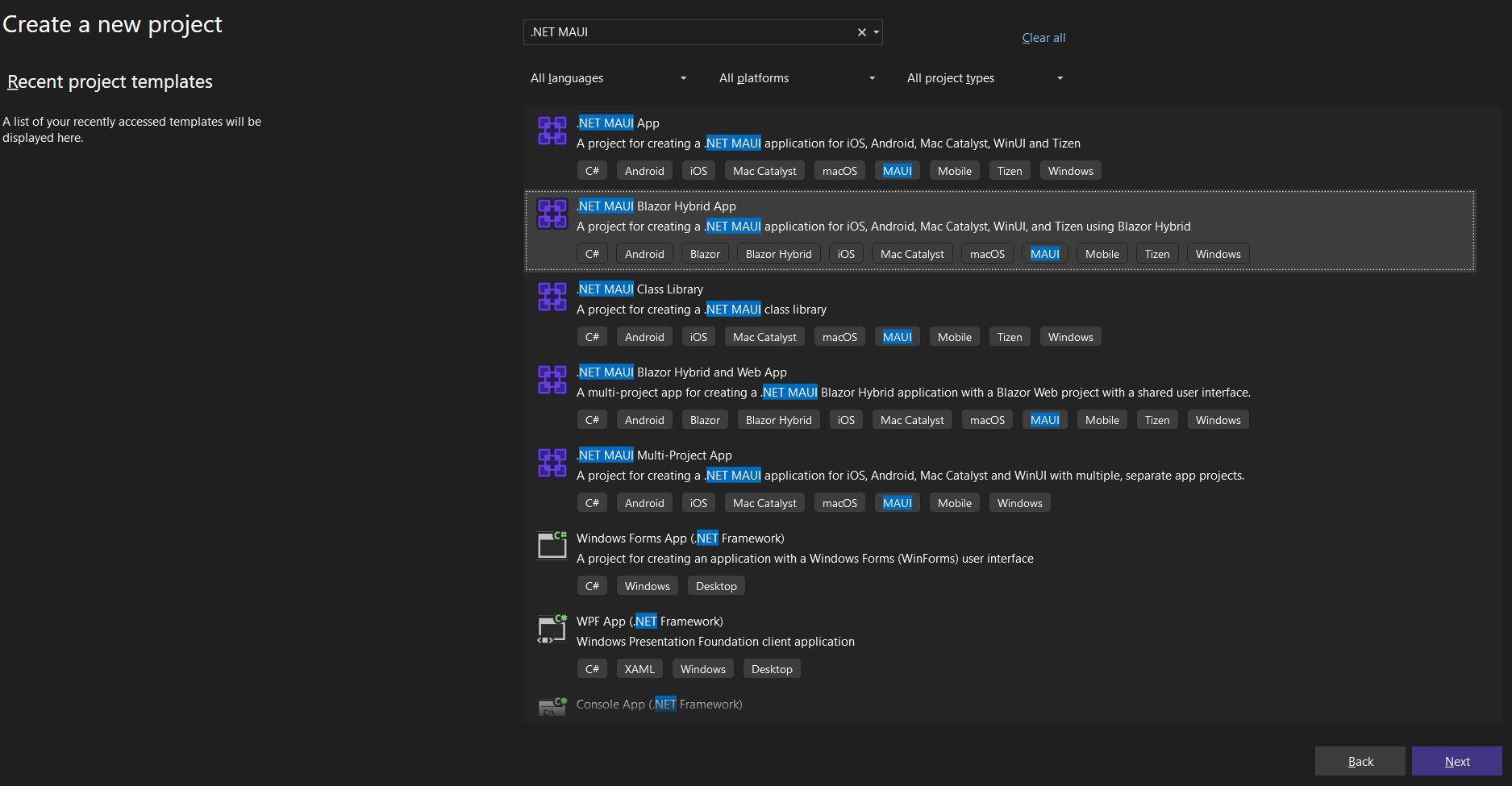
Step 2: Name the project.
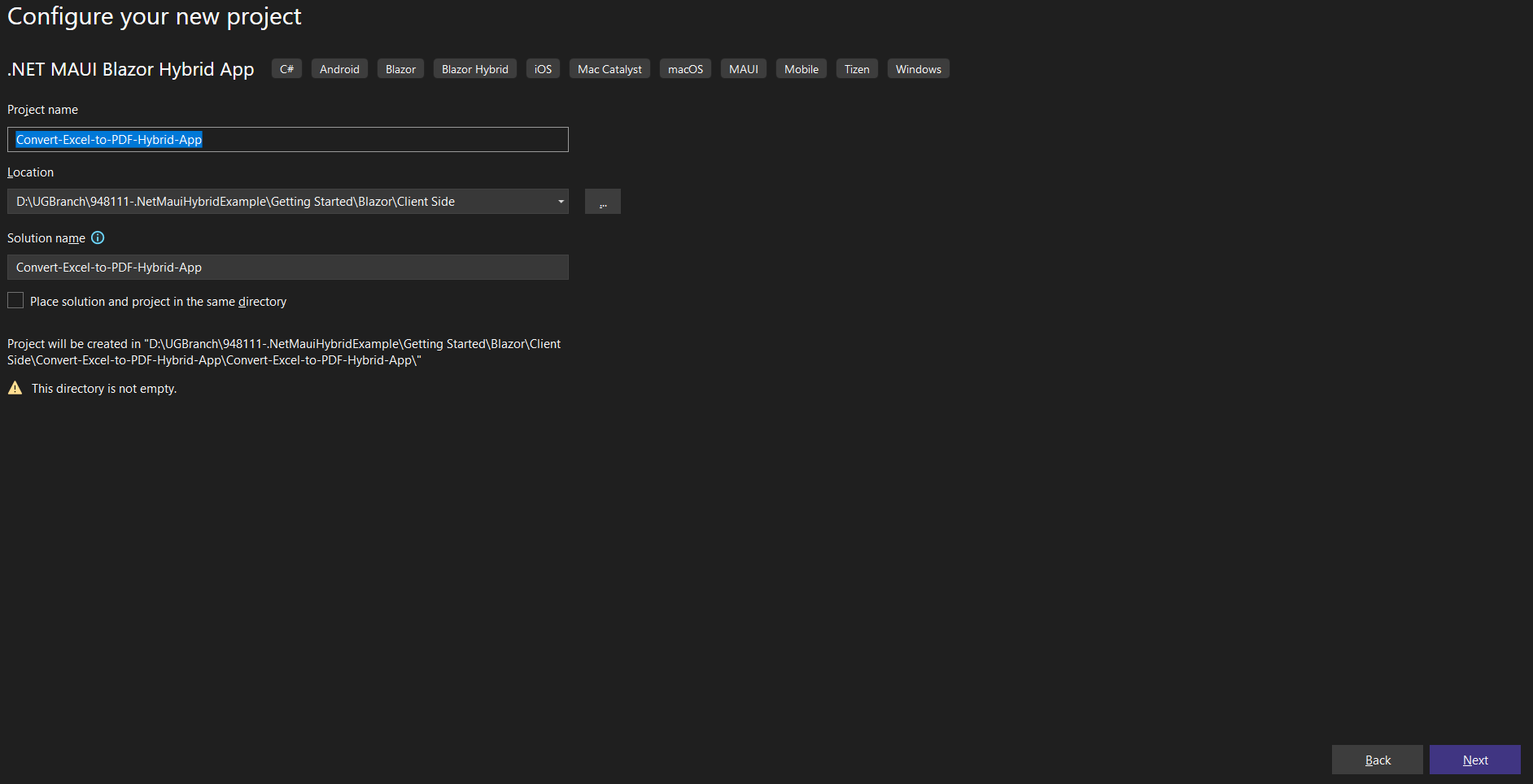
Step 3: Select the framework and click Create button.

Step 4: Install the following Nuget packages in your application from NuGet.org.
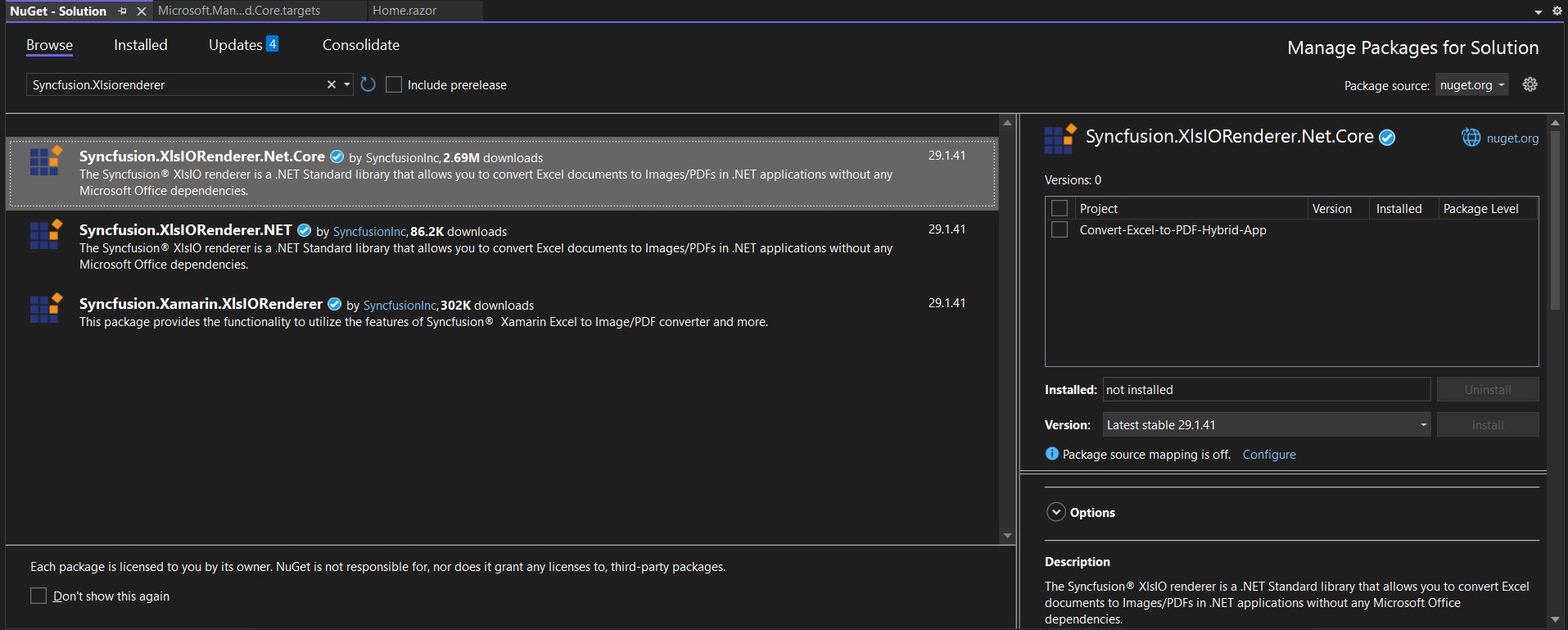
NOTE
Starting with v16.2.0.x, if you reference Syncfusion® assemblies from trial setup or from the NuGet feed, you also have to add “Syncfusion.Licensing” assembly reference and include a license key in your projects. Please refer to this link to know about registering Syncfusion® license key in your application to use our components.
Step 5: Add a new button in Pages/Home.razor
@page "/"
<h3>Convert Excel to PDF</h3>
<button class="btn btn-primary" @onclick="ConvertExceltoPDF">Convert Excel to PDF</button>Step 6: Include the following namespaces in the Pages/Home.razor file.
@using Syncfusion.XlsIO
@using Syncfusion.XlsIORenderer
@using Syncfusion.Pdf
@using System.IOStep 7: Include the following code in the Pages/Home.razor file.
@code {
private async Task ConvertExceltoPDF()
{
using ExcelEngine excelEngine = new();
IApplication application = excelEngine.Excel;
application.DefaultVersion = ExcelVersion.Xlsx;
string inputPath = Path.Combine(FileSystem.Current.AppDataDirectory, "InputTemplate.xlsx");
// Copy the Excel file from wwwroot to local app storage if it doesn't exist
if (!File.Exists(inputPath))
{
using Stream resourceStream = await FileSystem.OpenAppPackageFileAsync("wwwroot/data/InputTemplate.xlsx");
using FileStream outputStream = File.Create(inputPath);
await resourceStream.CopyToAsync(outputStream);
}
using FileStream excelStream = File.OpenRead(inputPath);
IWorkbook workbook = application.Workbooks.Open(excelStream);
XlsIORenderer renderer = new XlsIORenderer();
PdfDocument pdf = renderer.ConvertToPDF(workbook);
using MemoryStream stream = new();
pdf.Save(stream);
pdf.Close();
workbook.Close();
stream.Position = 0;
// Save the generated PDF to local storage
string outputDir = Path.Combine(FileSystem.Current.AppDataDirectory, "Output");
// Create folder if it doesn't exist
Directory.CreateDirectory(outputDir);
string outputPath = Path.Combine(outputDir, "Sample.pdf");
using FileStream fileStream = new FileStream(outputPath, FileMode.Create, FileAccess.Write);
stream.CopyTo(fileStream);
await Application.Current.MainPage.DisplayAlert("Success", $"PDF saved to:\n{outputPath}", "OK");
}
}Step 1: Create a new C# .NET MAUI Blazor Hybrid Application project.
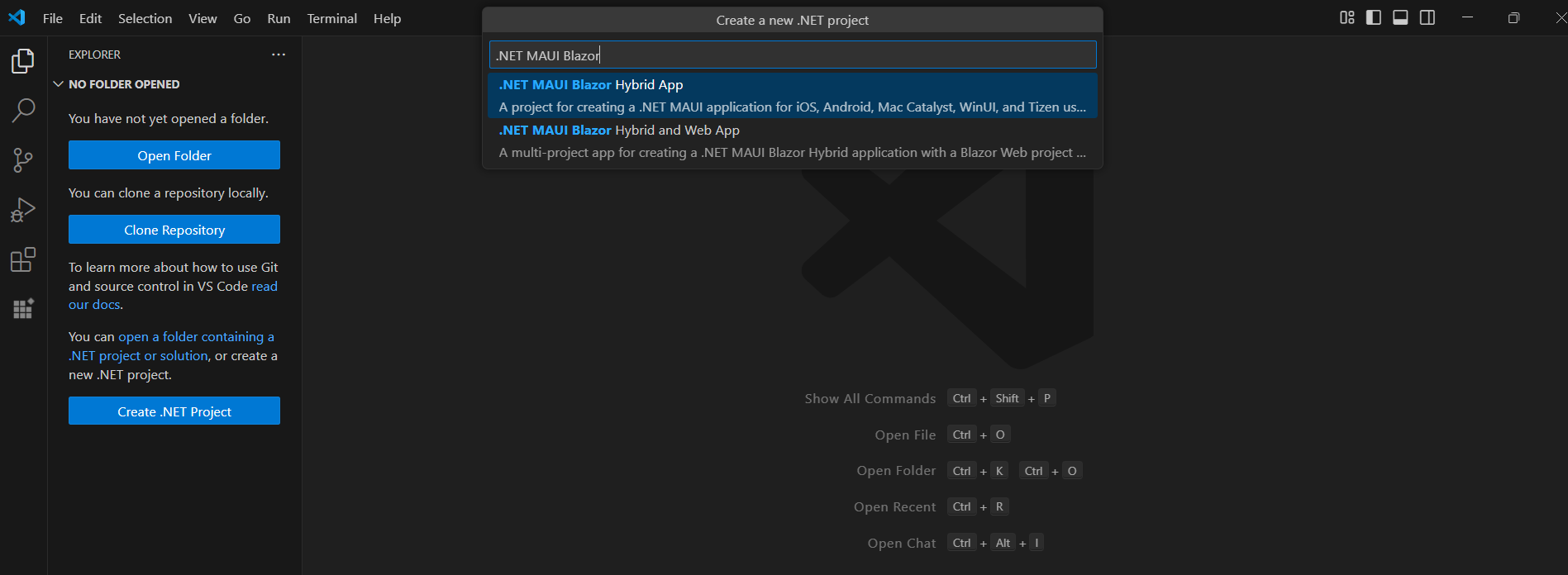
Step 2: Name the project and create the project.
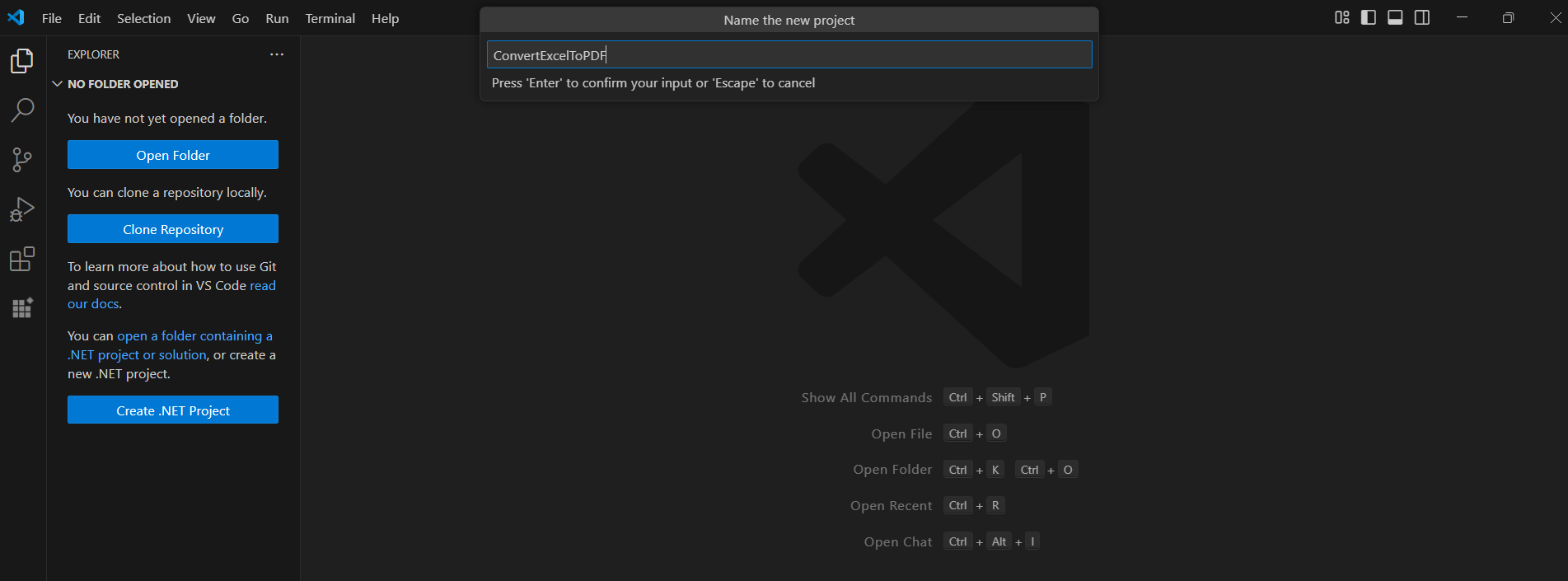
Alternatively, create a .NET MAUI Blazor Hybrid Application using the following command in the terminal(Ctrl+`).
dotnet new maui-blazor -n ConvertExcelToPdf
cd ConvertExcelToPdf
Step 3. To convert an Excel document to PDF in Blazor,run the following command to install Syncfusion.XlsIORenderer.Net.Core.

dotnet add package Syncfusion.XlsIORenderer.Net.Core
NOTE
Starting with v16.2.0.x, if you reference Syncfusion® assemblies from trial setup or from the NuGet feed, you also have to add “Syncfusion.Licensing” assembly reference and include a license key in your projects. Please refer to this link to know about registering Syncfusion® license key in your application to use our components.
Step 4: Add a new button in Pages/Home.razor
@page "/"
<h3>Convert Excel to PDF</h3>
<button class="btn btn-primary" @onclick="ConvertExceltoPDF">Convert Excel to PDF</button>Step 5: Include the following namespaces in the Pages/Home.razor file.
@using Syncfusion.XlsIO
@using Syncfusion.XlsIORenderer
@using Syncfusion.Pdf
@using System.IOStep 6: Include the following code in the Pages/Home.razor file.
@code {
private async Task ConvertExceltoPDF()
{
using ExcelEngine excelEngine = new();
IApplication application = excelEngine.Excel;
application.DefaultVersion = ExcelVersion.Xlsx;
string inputPath = Path.Combine(FileSystem.Current.AppDataDirectory, "InputTemplate.xlsx");
// Copy the Excel file from wwwroot to local app storage if it doesn't exist
if (!File.Exists(inputPath))
{
using Stream resourceStream = await FileSystem.OpenAppPackageFileAsync("wwwroot/data/InputTemplate.xlsx");
using FileStream outputStream = File.Create(inputPath);
await resourceStream.CopyToAsync(outputStream);
}
using FileStream excelStream = File.OpenRead(inputPath);
IWorkbook workbook = application.Workbooks.Open(excelStream);
XlsIORenderer renderer = new XlsIORenderer();
PdfDocument pdf = renderer.ConvertToPDF(workbook);
using MemoryStream stream = new();
pdf.Save(stream);
pdf.Close();
workbook.Close();
stream.Position = 0;
// Save the generated PDF to local storage
string outputDir = Path.Combine(FileSystem.Current.AppDataDirectory, "Output");
// Create folder if it doesn't exist
Directory.CreateDirectory(outputDir);
string outputPath = Path.Combine(outputDir, "Sample.pdf");
// Save the PDF to a file
using (FileStream fileStream = new FileStream(outputPath, FileMode.Create, FileAccess.Write))
{
stream.CopyTo(fileStream);
}
// Display alert with the actual file path
await Application.Current.MainPage.DisplayAlert("Success", $"PDF saved to:\n{outputPath}", "OK");
}
}A complete working example of how to convert an Excel document to PDF in .NET MAUI Blazor Hybrid App is present on this GitHub page.
By executing the program, you will get the PDF document as follows.

Click here to explore the rich set of Syncfusion® Excel library (XlsIO) features.
An online sample link to convert an Excel document to PDF in Blazor.